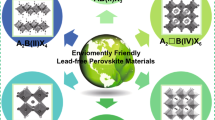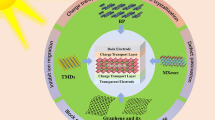Abstract
A facile all-sequential-dip-coating deposition of MAyFA1−yPbI3−xBrx perovskite layers from an aqueous halide-free lead precursor, Pb(NO3)2 were carried-out towards an efficient, low cost, and an environmentally friendly manufacturing approach for high-efficiency perovskite solar cells. The efficient MAyFA1−yPbI3−xBrx perovskite films were successfully realized by sequential dip-coating immersed in MABr and FAI mixed solution of Pb(NO3)2 layer deposited over a ZnO covered c-TiO2 bilayer substrate, in which the four-types of MABr/FAI proportions were investigated to modulate the cationic and anionic ligands such as MA/FA and Br/I components in formation of MAyFA1−yPbI3−xBrx perovskite structures. Although the characteristics of these MAyFA1−yPbI3−xBrx perovskite films were significantly affected by varying MABr/FAI molar ratios, the MAyFA1−yPbI3−xBrx perovskite films prepared with the 0.18-MABr/FAI presented the better light absorption efficiency, higher perovskite conversion factors, superior surface morphology, and better crystallinity with the appropriate Br insertion. The fabricated PrSCs devices with MAyFA1−yPbI3−xBrx perovskite films with 0.18-MABr/FAI exhibited a notable PCE value of 12.6% with high photocurrent of ~ 24 mA cm−2 and high photovoltage of 0.98 V, even it has a rather low fill factor of 0.54, providing efficient operational stability without any significant loss in photovoltaic performance for 500 h.






Similar content being viewed by others
Data availability
All data generated or analyzed during this study are included in this published article [and its supplementary information files.
References
B. Conings, J. Drijkoningen, N. Gauquelin, A. Babayigit, J. D’Haen, L. D’Olieslaeger, A. Ethirajan, J. Verbeeck, J. Manca, E. Mosconi, F.D. Angelis et al., Intrinsic thermal instability of methylammonium lead trihalide perovskite. Adv. Energy Mater. 5(15), 1500477 (2015)
C.C. Stoumpos, C.D. Malliakas, M.G. Kanatzidis, Semiconducting tin and lead iodide perovskite with organic cations phase transitions, high mobilities, and near-infrared photo-luminescent properties. Inorg. Chem. 52(15), 9019–9038 (2013)
W. Yan, H. Rao, C. Wei, Z. Liu, Z. Bian, H. Xin, W. Huang, Highly efficient and stable inverted planar solar cells from (FAI)x( MABr)1−xPbI2 perovskites. Nano Energy 35, 62–70 (2017)
N.J. Jeon, J.H. Noh, W.S. Yang, Y.C. Kim, S. Ryu, J. Seo, S.I. Seok, Compositional engineering of perovskite materials for high-performance solar cells. Nature 517(7535), 476–480 (2015)
C. Wu, X. Zheng, Q. Yang, Y. Yan, M. Sanghadasa, S. Priya, Crystallization of HC(NH2)2PbI3 black polymorph by solvent intercalation for low temperature solution processing of perovskite solar cells. J. Phys. Chem. C 120(47), 26710–26719 (2016)
L. Lin, T.W. Jones, J.T. Wang, A. Cook, N.D. Pham, N.W. Duffy, B. Mihaylov et al., Strategically constructed bilayer tin (IV) oxide as electron transport layer boosts performance and reduces hysteresis in perovskite solar cells. Small 16(12), 1901466 (2020)
X. Zheng, B. Chen, M. Yang, C. Wu, B. Orler, R.B. Moore, K. Zhu, S. Priya, The controlling mechanism for potential loss in CH3NH3PbBr3 hybrid solar cells. ACS Energy Lett. 1(2), 424–430 (2016)
M. Adnan, H.S. Kim, H. Jeong, H.M. Ko, S.K. Woo, J.K. Lee, Efficient synthesis and characterization of solvatochromic fluorophore. Bull. Korean Chem. Soc. 38(9), 1052–1057 (2017)
M. Adnan, J.K. Lee, Highly efficient planar heterojunction perovskite solar cells with sequentially dip-coated deposited perovskite layers from a non-halide aqueous lead precursor. RSC Adv. 10(9), 5454–5461 (2020)
M. Adnan, Z. Irshad, J.K. Lee, Facile all-dip-coating deposition of highly efficient (CH3)3NPbI3-xClx perovskite materials from aqueous non-halide lead precursor. RSC Adv. 10(48), 29010–29017 (2020)
M. Adnan, J.K. Lee, All sequential dip-coating processed perovskite layers from an aqueous lead precursor for high efficiency perovskite solar cells. Sci. Rep. 8(1), 1–10 (2018)
Z. Irshad, M. Adnan, J.K. Lee, Simple preparation of highly efficient MAxFA1-xPbI3 perovskite films from an aqueous halide-free lead precursor by all dip-coating approach and application in high-performance perovskite solar cells. J. Mater. Sci. 1–11 (2022)
Z. Irshad, M. Adnan, J.K. Lee, Controlling phase and morphology of all-dip-coating processed HC(NH2)2PbI3 perovskite layers from an aqueous halide-free lead precursor. J. Phys. Chem. Solids 160, 110374 (2022)
Z. Irshad, M. Adnan, J.K. Lee, Efficient planar heterojunction inverted perovskite solar cells with perovskite materials deposited using an aqueous non-halide lead precursor. Bull. Korean Chem. Soc. 41(9), 937–942 (2020)
P. Pinpithak, H.W. Chen, A. Kulkarni, Y. Sanehira, M. Ikegami, T. Miyasaka, Low-temperature and ambient air processes of amorphous SnOx based mixed halide perovskite planar solar cell. Chem. Lett. 46(3), 382–384 (2017)
T.J. Jacobsson, J.P. Correa-Baena, M. Pazoki, M. Saliba, K. Schenk, M. Grätzel, A. Hagfeldt, Exploration of the compositional space for mixed lead halogen perovskites for high efficiency solar cells. Energy Environ. Sci. 9(5), 1706–1724 (2016)
L. Yang, X. Wang, X. Mai, T. Wang, C. Wang, X. Li, V. Murugadoss, Q. Shao, S. Angaiah, Z. Guo, Constructing efficient mixed-ion perovskite solar cells based on TiO2 nanorod array. J. Colloid Interface Sci. 534, 459–468 (2019)
G. Liu, L. Zhu, H. Zheng, X. Xu, A. Alsaedi, T. Hayat, X. Pan, S. Dai, Highly efficient and humidity stable perovskite solar cells achieved by introducing perovskite-like metal formate material as the nanocrystal scaffold. J. Power Sources 402, 229–236 (2018)
M.D. Humadi, H.T. Hussein, M.S. Mohamed, M.K. Mohammed, E. Kayahan, A facile approach to improve the performance and stability of perovskite solar cells via FA/MA precursor temperature controlling in sequential deposition fabrication. Opt. Mater. 112, 110794 (2021)
R. Singh, H.K. Jun, A.K. Arof, Activated carbon as back contact for HTM-free mixed cation perovskite solar cell. Phase Trans. 91(12), 1268–1276 (2018)
P. Zardari, A. Rostami, H. Shekaari, p-Phenylenediaminium iodide capping agent enabled self-healing perovskite solar cell. Sci. Rep. 10(1), 1–14 (2020)
Y. Sun, J.H. Seo, C.J. Takacs, J. Seifter, A.J. Heeger, Inverted polymer solar cells integrated with a low-temperature-annealed sol-gel-derived ZnO film as an electron transport layer. Adv. Mater. 23(14), 1679–1683 (2011)
O. Malinkiewicz, A. Yella, Y.H. Lee, G.M. Espallargas, M. Graetzel, M.K. Nazeeruddin, H.J. Bolink, Perovskite solar cells employing organic charge-transport layers. Nat. Photonics 8(2), 128–132 (2014)
Y. Zhao, K. Zhu, CH3NH3Cl-assisted one-step solution growth of CH3NH3PbI3: structure, charge-carrier dynamics, and photovoltaic properties of perovskite solar cells. J. Phys. Chem. C 118(18), 9412–9418 (2014)
J.H. Heo, M.H. Lee, M.H. Jang, S.H. Im, Highly efficient CH3NH3PbI3−xClx mixed halide perovskite solar cells prepared by re-dissolution and crystal grain growth via spray coating. J. Mater. Chem. A 4(45), 17636–17642 (2016)
Funding
This study was supported by research fund from Chosun University, 2022.
Author information
Authors and Affiliations
Contributions
All authors contributed to the study conception and design. Material preparation, data collection and analysis were performed by ZI, MA, and JKL. The first draft of the manuscript was written by JKL and all authors commented on previous versions of the manuscript. All authors read and approved the final manuscript.
Corresponding author
Ethics declarations
Conflict of interest
The authors have no relevant financial or non-financial interests to disclose.
Additional information
Publisher's Note
Springer Nature remains neutral with regard to jurisdictional claims in published maps and institutional affiliations.
Supplementary Information
Below is the link to the electronic supplementary material.
Rights and permissions
About this article
Cite this article
Irshad, Z., Adnan, M. & Lee, J.K. Sequentially dip-coated processed MAyFA1−yPbI3−xBrx perovskite layers from an aqueous halide-free lead precursor for efficient perovskite solar cells. J Mater Sci: Mater Electron 33, 15132–15142 (2022). https://doi.org/10.1007/s10854-022-08432-1
Received:
Accepted:
Published:
Issue Date:
DOI: https://doi.org/10.1007/s10854-022-08432-1




